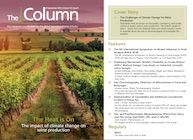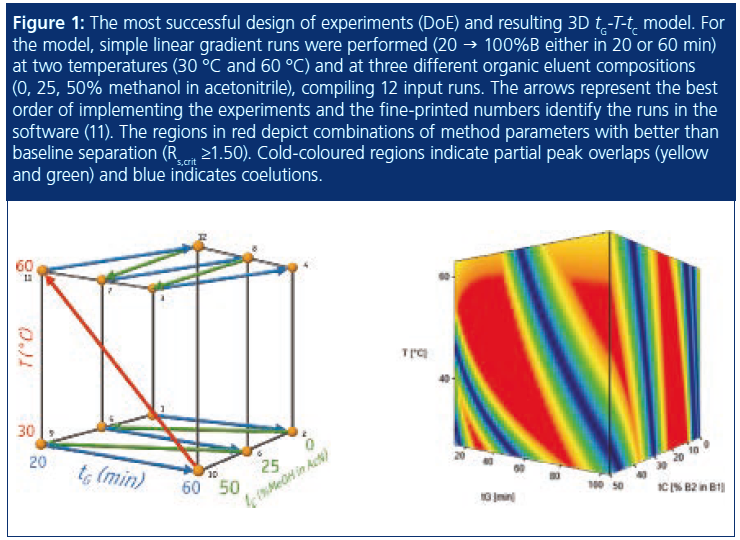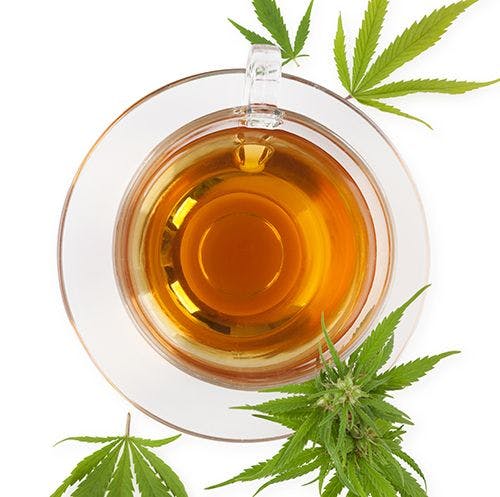The Challenges of Climate Change for Wine Production
Heatwaves are significantly affecting the consistency and quality of wine production. The Column spoke to Julia C. Gouot from the National Wine and Grape Industry Centre in Australia about the importance of chromatography to understand the effects of temperature change on grape physiology and composition.
Anton Petrus/stock.adobe.com

Heatwaves are significantly affecting the consistency and quality of wine production. The Column spoke to Julia C. Gouot from the National Wine and Grape Industry Centre in Australia about the importance of chromatography to understand the effects of temperature change on grape physiology and composition.
Q. Where did the original idea to study the effect of heatwaves on grape physiology and composition come from?A: During my master’s internship at the National Wine and Grape Industry Centre at Charles Sturt University, in Australia, I worked on a study looking at grapevine physiology and berry composition in Shiraz, the most planted red variety in Australia. The field trial lasted three years and vines were treated by removing leaves or fruit to generate different fruit-to-leaf ratios. Leaf removal, early in the growing season, exposed grapes to increased light and temperature and significantly impacted on phenolic composition of the subsequent wine, highlighting the importance of bunch microclimate on wine quality. In addition to this project, previous studies in Australia and around the world have examined the effect of light and interactions between light and temperature on grape composition (1). A few recent studies have reported the sole effect of temperature on grape physiology and composition, but to date, research focusing on short and intense exposure to temperature above 40 °C is rare (2).
In Australia, such temperatures are becoming more common and an increase in frequency and severity of heatwaves during the spring and summer months has been recorded. For example, summer 2018–19 was scorched by heat with three weeks of record-breaking temperatures ranging 38–46 °C in the Riverina in New South Wales in Australia. It is therefore important to understand the impact of such stressful events for Shiraz grapevines, planted in warm and hot grape growing regions, to be able to mitigate detrimental effects and predict grape composition at harvest to maintain wine quality.
Q. Are there specific compounds in the grapes that you are investigating?A: My Ph.D. project focuses on grape berry tannins, also known as proanthocyanidins, which are present in the skin and seeds. These compounds are polymers of flavanâ3âols and are part of the flavonoid family together with anthocyanins (red pigments) and flavonols (UV-protectors). They are important contributors to grape and wine quality, enhancing wine colour by copigmentation with anthocyanins and mouthfeel (astringency and bitterness). Despite several decades of research on flavonoid biosynthesis and biochemical responses to abiotic factors, knowledge is still lacking around tannin biosynthesis, particularly in relation to polymerization and galloylation (addition of a gallic acid moiety). Data on the direct effect of temperature, free from water stress and light alterations, on tannin accumulation and composition are also still limited (3).
Q. What is novel about your research?
A: Recent studies on temperature have not found any, or consistent, effects on tannins. My Ph.D. project provides a comprehensive study of the effect of high temperatures on detailed grape tannin composition. The project is revisiting the sole effect of temperature using potted vines in a controlled environment to see whether tannin accumulation is impacted or not. Experiments are conducted free from light interactions by using a UV-transparent glasshouse and system heating whole vines and bunches without affecting their exposure. Within the project, several temperature intensities, timing (day versus night), duration of exposure (three hours to three days) are tested at different phenological stages, with a focus on early berry development, when tannin biosynthesis is at its maximum. These experimental conditions, combined with the use of complex designs (biometrics and chemometrics) and analytical methods (targeted and untargeted metabolomics), contribute to the novelty of the project. Another aspect of my experiments is the study of whether the effect of more than one heatwave is additive (4). To our knowledge, this concept had only been studied once on wheat (5).
Q. What do your early results indicate is happening to the grape physiology and composition during these heatwaves?
A: Two physiological responses were observed depending on the maximum temperature reached by the berries, leading to distinct biochemical changes. Above a certain threshold, all parts of the bunch (bunch stem, pedicel, and berries) were visibly damaged with browning/necrosis appearing within a few hours of heating and complete berry desiccation within a few days. Green berries (before véraison, when berries soften and turn red) seemed to be more sensitive (maximum of 40–43 °C) than more mature red berries, which were injured at a more extreme temperature (50–53 °C). When berries were damaged, all flavonoids were significantly reduced, but proportions differed, suggesting biosynthesis deregulation or degradation.
On the other hand, berries that did not exhibit visible damage were still affected, with berry growth delayed and significant modulation of berry pulp, skin, and seed metabolism. For example, compounds from the myo-inositol pathway were all increased after three days of heat exposure when berries were green and small (20 days after fruit set). Acidity was reduced as a result of the sensitivity of malic acid to high day and night temperatures. Tannin accumulation was more affected in seeds than skin when heating was applied prior to véraison; however, after véraison, the opposite was observed and skin tannins significantly decreased in desiccated berries while seed tannins were preserved. Changes in composition and parameters were also found for heated treatments, with an increase in skin galloylation and longer seed tannins prior to véraison.
Q. What techniques are you using in this research?A: Methods previously developed by the polyphenol platform at INRA, in Montpellier, France, were adapted to our samples and liquid chromatography–electrospray ionization-triple quadrupoleâmass spectrometry (LC–ESI-QQQ-MS) equipment. One method examines tannin composition after chemical depolymerization (using phloroglucinolysis) and provides the concentration of terminal and upper/extension subunits (6). A second method targets a wide range of polyphenols including anthocyanins, free flavan-3-ols, and flavonols (7). Both methods are conducted on the same C18 column with the same solvents and use UV and MS detection, the latter configurated with multiple reaction monitoring (MRM) mode.
Untargeted metabolomic analyses are also conducted by gas chromatography (GC)–MS (quadrupole) for sugars, amino acids, and organic acids among a wide range of compounds (8). Benchtop spectrophotometry methods are also used for the rapid assessment of grape and wine colour and phenolic content throughout maturation and ageing.
Q. What analytical challenges did you encounter?A: Grape and wine samples are very complex matrices and metabolite concentrations vary within a given class of compounds, with tissue (skin, seed, pulp), and throughout ripening. Metabolites also vary whether in grape or wine, with some compounds only present in one or the other. To overcome these problems, berry sample preparation was adjusted based on tissue and ripeness by varying the tissue–extraction solvent ratio. Additional analytical adjustments included dilutions, different injection volumes (LC–MS), or use of spitless or different split ratios (GC–MS). The use of LC coupled with specific and sensitive detection modes, such as MRM, allowed the quantification of minor compounds not previously studied.
In addition, the high number of samples to process is challenging as each berry sample is divided into three sub-samples of skin, seeds, and pulp, each multiplied by the number of treatments and biological and analytical replicates. For each experiment, large data sets are generated as thousands of samples are analyzed using several methods to gain a comprehensive picture, with the total number of targeted compounds averaging at around 200. To ensure data robustness, methods were developed to be as short as possible and samples were run together for each tissue and experiment. Data were meticulously processed to ensure reproducibility over the duration of the analyses using quality controls to overcome instrumental instability (9).
Q. How could your results influence how grape growers and winemakers produce wine in the future?A: We hope the project will help with immediate and long-term economic benefits for growers and winemakers. In the short term, understanding the physiological responses of berries to high temperature may inform when berry survival is at risk. Growers already have several methods to mitigate heatwave effects, such as hydrocooling, berry sunscreen, and shade cloth. However, the timing of application for these methods must be fine-tuned for optimal and cost-effective protection.
In addition, understanding and predicting the effect of temperature on berry flavonoid composition and extractability at harvest may allow adaptation of winemaking protocols. In the long term, the work will assist with strategic planning for established and developing regions by providing insights into the temperature extremes or events that may be at the upper limit for grape production viability.
Q. Are there plans to extend this research further?A: Some of the changes in tannin accumulation can be explained by a disruption of berry development (delayed with less skin surface and smaller/greener seeds). Changes in composition could also either be a result of a potential deregulation of some genes involved in tannin biosynthesis, or enzymatic or chemical degradation. To confirm the first hypothesis, further molecular biology work is needed as most genes regulating tannin galloylation and polymerization are still unknown. For the second hypothesis, identifying degradation compounds, which is complicated because of their small concentrations, will help elucidate mechanisms of degradation.
Heat stress tolerance is known to vary with grape variety and the same study could be expanded to others, either planted in warm to hot grape growing regions (for example, Malbec, Grenache), or on widespread varieties, such as Cabernet Sauvignon.
References
- M. Downey, N.K. Dokoozlian, and M.P. Krstic, American Journal of Enology and Viticulture 57(3), 257–268 (2006).
- S.D. Cohen, J.M. Tarara, G.A. Gambetta, M.A. Matthews, and J.A. Kennedy, Journal of Experimental Botany63(7), 2655–2665 (2012). doi: 10.1093/jxb/err449
- J.C. Gouot, J.P. Smith, B.P. Holzapfel, A.R. Walker, and C. Barril, Journal of Experimental Botany70(2), 397–423 (2019).
- J.C. Gouot, J.P. Smith, B.P. Holzapfel, and C. Barril, OENO One53(2), 397–423 (2019). doi: org/10.20870/oeno-one
- B. Wollenweber, J.R., Porter, and J. Schellberg, Journal of Agronomy & Crop Science189, 142–150 (2003).
- L. Pinasseau, A. Verbaere, M. Roques, E. Meudec, A. Vallverdú-Queralt, N. Terrier, J.-C. Boulet, V. Cheynier, and N. Sommerer, Molecules21(10), 1409 (2016).
- L. Pinasseau, A. Vallverdú-Queralt, A. Verbaere, M. Roques, E. Meudec, L. Le Cunff, J.-P. Peros, A. Ageorges, N. Sommerer, and J.-C. Boulet, Frontiers in Plant Science8, 1826 (2017).
- G. Rossouw, B. Holzapfel, S. Rogiers, J. Gouot, and L. Schmidtke, Australian Journal of Grape and Wine Research25(3), 316–326 (2019). doi: 10.1111/ajgw.12395
- C. Ehrhardt, P. Arapitsas, M. Stefanini, G. Flick, and F. Mattivi, Journal of Mass Spectrometry49(9), 860–869 (2014).

Julia C. Gouot received her education in France and graduated with a Diplome National d’Oenologue and an agronomy engineer degree from the École Nationale Supérieure Agronomique de Toulouse (ENSAT), in France. She also did a research master’s in analytical chemistry/chemometrics in AgroParisTech (France). She first joined the NWGIC (National Wine and Grape Industry Centre, Australia) to finalize her master’s degree and complete a 6-month internship with Celia Barril in 2015. In 2016, she was awarded a scholarship from Charles Sturt University (CSU) in Australia, and started her Ph.D. with Dr Barril on the effect of high and extreme high temperatures on Shiraz grape tannin composition.

Celia Barril is Julia Gouot’s supervisor and was also involved in this research. She completed her education in France, Ireland, England, and Australia, graduating with a B.Sc. in chemistry, a master’s in organic and analytical chemistry, and a PhD on “The chemistry of ascorbic acid and sulfur dioxide as an antioxidant system relevant to white wine”. Celia is now a senior lecturer in chemistry and Course Director for the B.Sc. and wine and viticulture courses at Charles Sturt University. Her research focuses on grape and wine composition, using analytical techniques-mainly chromatography-to understand the impact of vineyard practices, abiotic factors, or wine production/storage conditions on grape and wine quality.
E-mail: nwgic@csu.edu.au
Website: www.csu.edu.au/nwgic

Silvia Radenkovic on Building Connections in the Scientific Community
April 11th 2025In the second part of our conversation with Silvia Radenkovic, she shares insights into her involvement in scientific organizations and offers advice for young scientists looking to engage more in scientific organizations.
Analytical Challenges in Measuring Migration from Food Contact Materials
November 2nd 2015Food contact materials contain low molecular weight additives and processing aids which can migrate into foods leading to trace levels of contamination. Food safety is ensured through regulations, comprising compositional controls and migration limits, which present a significant analytical challenge to the food industry to ensure compliance and demonstrate due diligence. Of the various analytical approaches, LC-MS/MS has proved to be an essential tool in monitoring migration of target compounds into foods, and more sophisticated approaches such as LC-high resolution MS (Orbitrap) are being increasingly used for untargeted analysis to monitor non-intentionally added substances. This podcast will provide an overview to this area, illustrated with various applications showing current approaches being employed.
Regulatory Deadlines and Supply Chain Challenges Take Center Stage in Nitrosamine Discussion
April 10th 2025During an LCGC International peer exchange, Aloka Srinivasan, Mayank Bhanti, and Amber Burch discussed the regulatory deadlines and supply chain challenges that come with nitrosamine analysis.
Silvia Radenkovic on Her Research and Passion for Scientific Collaboration
April 3rd 2025Silvia Radenkovic is a laboratory clinical biochemical genetics fellow at UMC Utrecht, the Netherlands and a member of Females in Mass Spectrometry (FeMS). She is currently doing a clinical fellowship where she is involved in diagnosing and helping treat patients with inborn metabolic diseases (IMD). Her research focuses on IMD such as congenital disorders of glycosylation (CDG), omics techniques such as tracer metabolomics, and different disease models.












